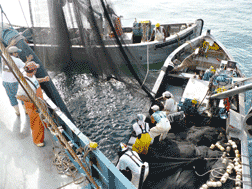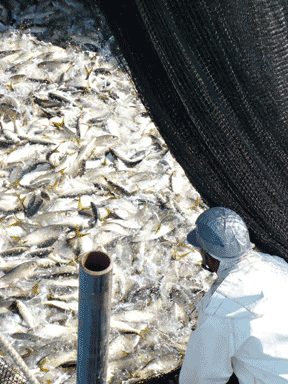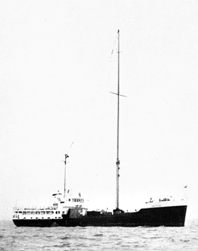|
|||||||||||
|
|||||||||||
|
|||||||||||
Still Serving after All These YearsHow World War II ships came to catch Chesapeake menhadena Bay Weekly exclusive by Ben MillerMystery ships sail the lower Bay.
Their names have changed many times; their origins are often obscure. Yet each ship has a legendary history: of war, tropical islands, foreign ports and now, fish. Two facts are certain in these ships’ murky histories. The ships were built to haul cargo in the South Pacific during World War II. Today, more than half a century later, they are fishing boats sailing out of Reedville, Virginia. How did these seaworthy, ocean-going ships end up fishing for one of the sea’s smallest, but to some most important, fish? From War to FishThe little fish is the big story in Reedville. The big boats that catch the little menhaden have another, less familiar, story to tell. They’re the boats that helped win the war — the big one — World War II. That is a story well known, but not often told: how American industrial engineering and production supplied the material that helped turn the tide of war. As tanks and airplanes poured out of manufacturing plants by the thousands, American shipyards produced destroyers, aircraft carriers, submarines and Liberty and cargo ships for the war at sea. Many of the boats of the menhaden fishing fleet came down the ways of shipyards across America in 1943 and 1944, built as light cargo ships for the U.S. Army Transportation Service. Some sailed in the South Pacific during the war. Captained by U.S. Coast Guard officers, they supplied ports in New Guinea and the Philippines. Others, like the menhaden fleet’s Atlantic Mist, were built as Patrol Escort Craft for the U.S. Navy. The ships became part of the U.S. Navy’s fleet after World War II. Many served as supply ships during the Korean War. The USS Estero earned seven battle stars in that war. Then their fates diverged. Some were transferred to the navy of South Korea. Others were sold to become merchant ships or to be taken apart for scrap. The fate of many is “disposition unknown.” A few ships remained a part of the U.S. Navy. The USS Mark served in 10 campaigns during the Vietnam War. The USNS New Bedford is now a tuna long-liner, the Sea Bird, operating out of San Diego, California. Ten military ships converted to fishing boats are part of the menhaden fishing fleet out of Reedville, Virginia. Little Fish; Big FortunesThere is big money in menhaden. Menhaden have been processed for fertilizer, animal food and fish oil since early in the 1800s. Since 1874, menhaden fishing in the Atlantic has centered in Reedville, on the Bay just below the Potomac River. By the turn of the 19th century, Reedville menhaden captains had built themselves a line of stately Victorian houses called Millionaires’ Row. From menhaden, big money is still being made. Today the Omega Protein company fishes for menhaden on an industrial scale. To Reedville’s fleet of 10 boats — formerly ships that helped win the war against Japan — Omega adds 30 more vessels fishing out of Abbeville and Cameron, Louisiana and Moss Point, Mississippi. Reedville, however, is still king. The menhaden catch makes Reedville (population 500) the second largest fishing port by weight of catch in the United States, behind Kodiak, Alaska. For Omega, and Reedville, menhaden make a modern-day fortune. With a $47 million capital investment in Reedville, the company pays 328 employees $13.25 million in salaries and spends another $10 million on their Virginia operation each year. The menhaden industry is “the life blood of that community,” said Omega spokesman Ben Landry. The Harvest of MenhadenOmega promotes itself as providing the Omega-3 fish oil capsules many of us are encouraged to take for our heart’s health. Four years ago, the company built a $14 million plant in Reedville to produce capsules that meet the human-consumption standards of the Food and Drug Administration. Omega reduction plants also produce fishmeal, high in protein, which ends up in chicken and other livestock feeds, as well as the food we give our dogs and cats; It’s also fed back to fish in fish farms.
As with any resource-extracting industry, there is controversy. Maryland has spatted with Virginia over the scope of the fishery. In 2006 and 2007, Omega’s boats harvested just under 109 metric tons of menhaden from Chesapeake Bay. Maryland environmentalists and sport fishermen fear that industrial mining of this critical link in the food chain will diminish the populations of striped bass and other game fish so valuable to the economy of the Bay. Menhaden are also filter-feeders, like oysters, still in numbers large enough to improve Bay water quality. The Maryland Department of Natural Resources, the Environmental Protection Agency’s Chesapeake Bay Program and the Chesapeake Bay Foundation all express concern over a perceived decline in the number of young menhaden in the Bay. Omega Protein says there is no problem. “Menhaden are not being overfished,” Landry said. The company bases this claim on fish stock assessment estimates by the National Marine Fisheries Service. In Chesapeake Bay, the company abides by the cap set for 2006-2010 by the governments of Virginia and Maryland. “We go by science, not politics,” Landry said. Landry stands by industry estimates that only two out of every 1,000 menhaden are caught by commercial fishing boats. “The other 998 become forage for predators,” Landry said. Bay predators include striped bass and bluefish, as well as herons, egrets, ospreys and eagles. Predatory or not, the menhaden fishery is a large-scale industrial operation, closer to commercial tuna fishing than the small-scale fishing of independent Bay watermen. The converted fishing boats of Reedville are “blue-water boats, fast, with fine lines, suitable for the nasty weather encountered in the Atlantic,” said Mike Wilson of Omega Protein’s shipyard in Moss Point, Mississippi. “Fishermen like them,” he said. As the half-century-old fleet fans out into the Bay and the Atlantic, spotter planes search from the air for the schooling menhaden. Pilots look for a large, dark spot in the water overhung by wheeling gulls, indicating a huge school of fish. Alerted by the pilot, each ship closes in on the school. The crew on the ships then lower two smaller purse boats over the side. Fishermen on the purse boats encircle the fish with a purse seine. The fish are trapped, the net is closed and drawn in by fishermen to collect the catch. Then the big boat comes alongside to pump the harvest into its refrigerated hold. Each of the old Pacific campaign boats can store up to 500 tons of fish. Finally, they chug back to Reedville, where they are onloaded at the rendering plant. Sea ChangeHow did these ships end up fishing for menhaden in Chesapeake Bay? It is here that the boats’ histories become unclear.
The people who sail them often have only a hazy notion of a boat’s history, much as a family has little knowledge of the people who occupied a house before they did. Ships are sold. Names are changed. Structures are reconfigured. The boats of Omega Protein’s Reedville menhaden fishing fleet bear little resemblance to the ships of World War II. “Sailors on the original boats wouldn’t recognize these boats,” said Captain Paul Somers, a menhaden-boat captain living in White Stone, Virginia. “Their outlines have completely changed.” The biggest change was that the wheelhouses were moved forward. To hold fish, the holds have been converted with lots of refrigeration piping. A few boats have plaques in their engine rooms attesting to their naval service. Tying Up One Boat’s HistoryOne of the most famous of this Reedville fleet is the Earl J. Conrad Jr. In its 65 years, the 166-foot-long boat has sailed under six names, from the USS Deal to the Akuarius, or Akvarius, according to the Lloyd’s Register of shipping. In the early 1970s, the ship was purchased and converted to a menhaden fishing boat by the company now known as Omega Protein Inc. and rechristened the Earl J. Conrad Jr. Captain Somers is her captain. His boat is very seaworthy, Somers says, explaining why the 50-plus year-old boats are still in service. The fame of the Earl J. Conrad Jr. is due not to its wartime service as the USS Deal but to its brief career as the Olga Patricia, renamed Laissez Faire, a floating pirate radio station. Built in 1944 in the Wheeler Shipbuilding Corporation in Whitestone, New York, for the U.S. Army Transportation Service, the ship was numbered FS-263.
FS-263 was named USAT Deal for Deal Island in Chesapeake Bay west of Salisbury. She was manned by the U.S. Coast Guard, with Lieutenant Junior Grade W.G. Hill her first commanding officer. During World War II, she operated in the South Pacific out of New Guinea, ferrying supplies from port to port. Decommissioned at war’s end, Deal came to the navy and was commissioned as Miscellaneous Auxiliary, USS Deal (AG-131) at Apra, Guam, in March, 1947. With Lieutenant Junior Grade P.G. Patton commanding, she carried cargo to the Pacific islands out of Guam until 1949, when she berthed in Pearl Harbor. The USS Deal (AKL-2) ferried equipment and supplies during the Korean War as part of the 7th Fleet out of Sasebo, Japan. She was decommissioned in 1955 and laid up in Puget Sound (Bremerton) until she was sold in 1961. After a brief period working as a cargo ship in the Caribbean in the early 1960s as the Don Carlos, the ship was rechristened the M/V Olga Patricia and later the M/V Laissez Faire. Fitted with a towering antenna, the Olga Patricia/Laissez Faire attained some measure of notoriety as a pirate radio ship operating off the coast of England in 1966. That’s after the 160-foot antenna snapped in rough seas and fell overboard when the floating radio station was barely out of Miami on her Atlantic crossing. The ship had to drag the antenna to the Azores to get help to haul it on board. The antenna was reset in Lisbon. Broadcasting to England and Europe on a powerful 50,000 watt AM station called Swinging Radio England, American disc jockeys excited teenagers with rapid-fire, personalized patter and rock and roll music. The station, the project of Texas entrepreneur Don Pierson, was unsuccessful financially and was short-lived. But not forgotten. This swashbuckling radio adventure is fondly remembered by both the boss jocks who broadcast from on board and their now-aging British and European fans who listened on their radios. How do we know? By the powers of the Internet. Svenn Martinsen sent an inquiry to Bay Weekly from Norway. Martinsen sought photos of former AKL/FS ships now being used as fishing boats by Omega Protein Inc. of Reedville, Virginia. Specifically, he wanted to know about the Earl J. Conrad Jr. He’d been one of the excited kids who listened to radio broadcasts from the ship in 1966-’67. “I love those stations created by Don Pierson, of Eastland, Texas,” said Martinsen. Thus our story began. Special thanks to two sources, Martinsen, who hopes to learn more from Bay Weekly readers ([email protected]) and Bill Rottkamp, of White Stone, Virginia, a sailor who interviewed Captain Paul Somers and supplied information on the menhaden fishery.
|
|||||||||||
|
|||||||||||
|
|
|||||||||||
|
© COPYRIGHT 2008 by New Bay Enterprises, Inc. All rights reserved.
|
|||||||||||






